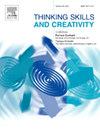“满足学生的需要很重要”:哈萨克斯坦教师对创造创造性环境的信念
IF 4.5
2区 教育学
Q1 Social Sciences
引用次数: 0
摘要
创造力在教育领域的重要性得到了广泛认可。然而,在苏联解体后的背景下,特别是在哈萨克斯坦,这是一个尚未得到很多关注的问题。目前,国际上很少有关于高中教师创造力信念的研究证据。因此,本研究的目的是探讨这些教师如何将创造性学习环境概念化,包括他们对构成这种环境的因素的看法,以及如何在课堂上培养创造力。该研究是一项定性的多案例研究,包括四种不同类型的哈萨克斯坦中学。数据收集包括15个深度半结构化访谈。本研究采用了一个改进的教师创造力信念概念框架(Bereczki & Kárpáti, 2018)。研究结果显示,教师关于创造创造性环境的信念与世界各地的许多实证研究结果一致。然而,本研究的一个值得注意的发现是,本研究的初始概念框架的创造性环境结构扩展了一个额外的子结构:学生的需求。这项研究的独特之处在于,参与者认为,如果学生的需求(基本的和心理的)没有得到满足,如果物理环境不令人满意,创造性的环境就不能完全有效。本文章由计算机程序翻译,如有差异,请以英文原文为准。
“Meeting students’ needs matters”: Kazakhstani teachers’ beliefs about developing a creative environment
The significance of creativity in the educational sphere is widely recognized. However, this is a topic that has yet to receive much attention in the post-Soviet context and more specifically Kazakhstan. Currently, there is little international evidence of research on upper-secondary school teachers’ beliefs about creativity. Thus, the aim of the study was to explore how these teachers conceptualize a creative learning environment, including their beliefs about what constitutes such an environment, and how creativity can be developed in the classroom. The research was designed as a qualitative, multiple-case study comprising four different types of Kazakhstani secondary schools. Data collection included 15 in-depth semi-structured interviews. A modified conceptual framework for teachers’ beliefs about creativity (Bereczki & Kárpáti, 2018) was employed in this study. The findings revealed that teachers’ beliefs about developing a creative environment align with many empirical findings worldwide. However, a noteworthy finding of this study was that the creative environment construct of this study’s initial conceptual framework was expanded with an additional subconstruct: students’ needs. Unique to this study was that participants believe a creative environment cannot be fully effective if students’ needs (basic and psychological) are not met and if the physical environment is unsatisfactory.
求助全文
通过发布文献求助,成功后即可免费获取论文全文。
去求助
来源期刊

Thinking Skills and Creativity
EDUCATION & EDUCATIONAL RESEARCH-
CiteScore
6.40
自引率
16.20%
发文量
172
审稿时长
76 days
期刊介绍:
Thinking Skills and Creativity is a new journal providing a peer-reviewed forum for communication and debate for the community of researchers interested in teaching for thinking and creativity. Papers may represent a variety of theoretical perspectives and methodological approaches and may relate to any age level in a diversity of settings: formal and informal, education and work-based.
 求助内容:
求助内容: 应助结果提醒方式:
应助结果提醒方式:


